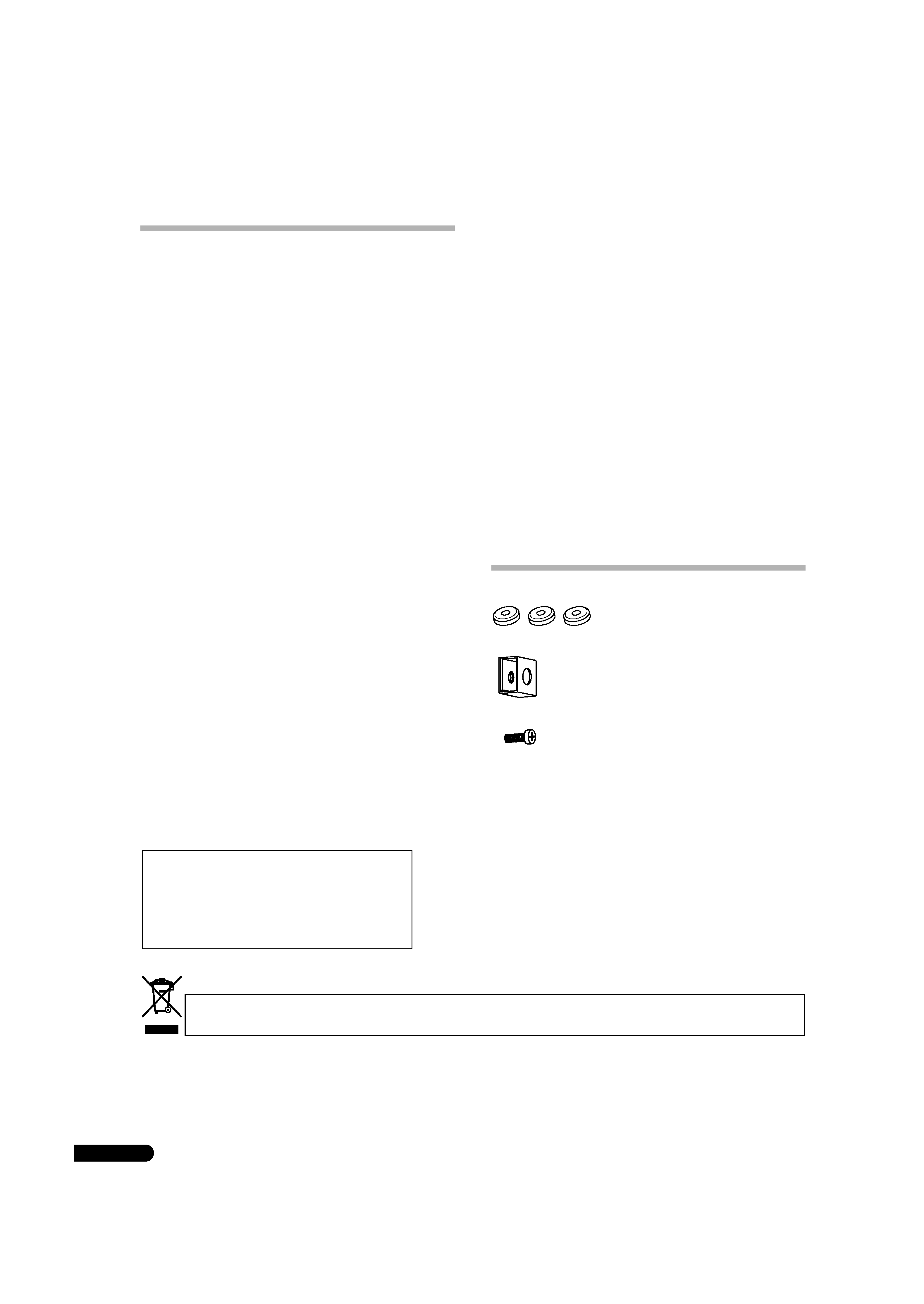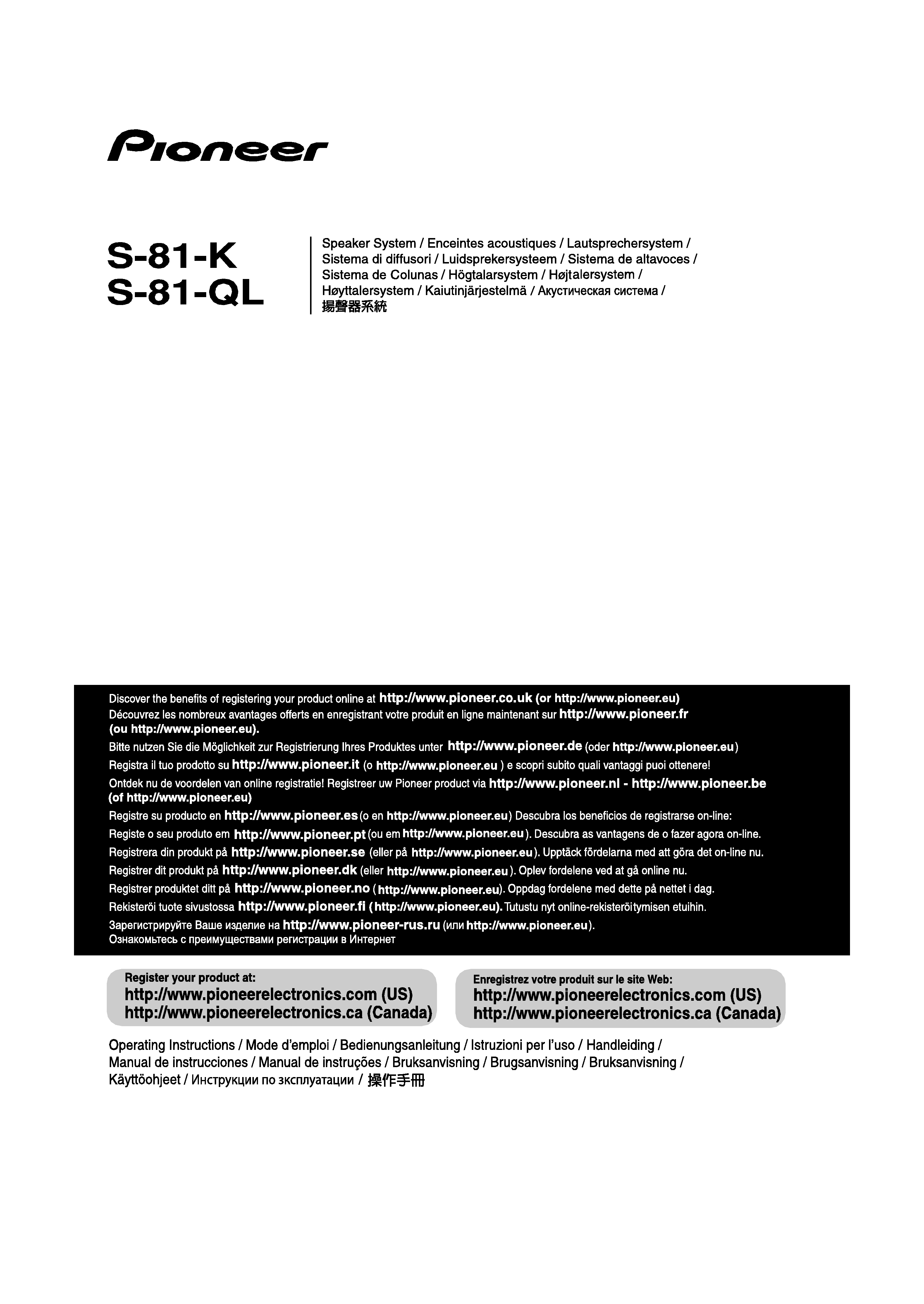
2
En
Thank you for buying this Pioneer product.
Please read through these operating instructions so you will know how to operate your model properly. After you have finished reading the
instructions, put them away in a safe place for future reference.
Before you start
· The nominal impedance of this speaker system is 6
.
Connect the speaker system to an amplifier with a load
impedance ranging from 6
to 16 (a model with "6 to
16
" displayed on the speaker output terminals).
In order to prevent damage to the speaker system resulting
from input overload, please observe the following precautions:
· Do not supply power to the speaker system in excess of the
maximum permissible input.
· When using a graphic equalizer to emphasize loud sounds
in the high-frequency range, do not use excessive amplifier
volume.
· Do not try to force a low-powered amplifier to produce loud
volumes of sound (the amplifier's harmonic distortion will
be increased, and you may damage the speaker).
Caution: installation
· When placing this unit, ensure that it is firmly secured and
avoid areas where it may be likely to fall and cause injury in the
event of a natural disaster (such as an earthquake).
· Do not attach these speakers to the wall or ceiling. They may
fall off and cause injury.
· Do not install your speakers overhead on the ceiling or wall. If
improperly attached, the speaker grille can fall and cause
damage or personal injury.
· Switch off and unplug your AV equipment and consult the
instructions when connecting up components. Make sure you
use the correct connecting cables.
· The grille is affixed with magnets. The grille may fall if force is
applied to the grille in a horizontal direction. When cleaning
the speaker, remove the grille first.
Caution: in use
· Do not place the speaker on an unstable surface. It could
present a hazard if it falls, as well as damaging the equipment.
· Do not use the speaker to output distorted sound for long
periods of times. This can result in a fire hazard.
· Do not sit or stand on the speaker, or let children play on the
speaker.
· Do not put large or heavy objects on top of the speaker.
· Do not place magnetic objects such as screwdrivers or iron
parts near the tweeter or midrange. Since the speakers use
strong magnets, the objects may be attracted, causing injury
or damaging the diaphragm.
Cleaning the speaker cabinet
With normal use, wiping with a dry cloth should be sufficient to
keep the cabinet clean. If necessary, clean with a cloth dipped in
a neutral cleanser diluted five or six times with water, and wrung
out well. Do not use furniture wax or cleansers.
Never use thinners, benzine, insecticide sprays or other chemicals
on or near this unit since these will corrode the surfaces.
Cleaning the glossy finish of the speaker system
S-81-K only
· If you use a dusty or hard cloth or if you rub the screen hard,
the finish of the product will be scratched.
· If you clean the surface of the speaker system with a wet cloth,
water droplets on the surface may enter into the product,
resulting in malfunction.
· When cleaning the finish of the speaker system, gently wipe it
with a dry soft cloth; the supplied cleaning cloth.
What's in the box
Spike bases x 3
Metal catch x 1
Screw (for metal catch) x 1
Grille x 1
Cleaning cloth (for S-81-K only) x 1
Operating instructions
For U.S. model
For European model
WARNING: Handling the cord on this product or
cords associated with accessories sold with the
product will expose you to chemicals listed on
proposition 65 known to the State of California and
other governmental entities to cause cancer and
birth defect or other reproductive harm.
D36-P4_A_En
Wash hands after handling
If you want to dispose this product, do not mix it with general household waste. There is a separate collection system for used
electronic products in accordance with legislation that requires proper treatment, recovery and recycling.
Private households in the member states of the EU, in Switzerland and Norway may return their used electronic products free of charge to
designated collection facilities or to a retailer (if you purchase a similar new one).
For countries not mentioned above, please contact your local authorities for the correct method of disposal.
By doing so you will ensure that your disposed product undergoes the necessary treatment, recovery and recycling and thus prevent potential
negative effects on the environment and human health.
K058_A_En
FRRD-232-A_S-81_En.book
2












